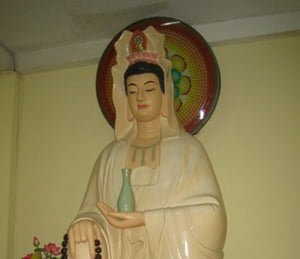 Sutra recitation is the principal practice of Vietnamese Buddhism.
Sutra recitation is the principal practice of Vietnamese Buddhism.
It is performed daily by monks and dedicated lay-people, and to sit in a monastery garden and listen to the heavenly sound of monastic voices chanting the scriptures, accompanied by bell and wooden drum, is one of my favourite things to do. Actually taking part in the chanting is a little more demanding, however. Though I am reasonably familiar with the liturgy (at one stage in my life I was a dedicated attender of evening sutra chanting), I still find the whole thing exhausting, involving as it does complicated shufflings of books and chanting sheets, bowing at the appropriate areas, and just keeping up with the sometimes dizzying pace of the chants. To complicate matters more, last time I was in Vietnam I was attending a Vajrayana temple in my suburb, where the whole practise of sutra chanting is ten-times more complicated. I was always doing something wrong, and being reprimanded by the elderly ladies who saw themselves as the guardians of correct conduct in the temple. So here is a list of sutras you will regularly encounter in the Vietnamese Buddhist context. I don't for a moment pretend to be a Buddhist scholar, so offer no analysis of the texts discussed. All I can do is describe them how I, in my ignorance, see them, and attempt to instruct you on when and how they are used. I'm happy to receive any corrections or further insights. 1. The Lotus Sutra: This is the grand-daddy of sutras in Vietnamese Buddhism. Most temples use this sutra as their fundamental text, and congregations chant their way through it a couple of times in the course of a year. Monks tell me that it offers the highest teaching of Mahayana Buddhism, and so can safely be taught across all sects and schools. Those of you familiar with Japanese Buddhism will be well aware of th importance of the Lotus Sutra in that culture as well. I have worked my way through it in English a couple of times, but will confess that it leaves more-or-less bewildered. I prefer chanting it in Vietnamese, where I don't feel obliged to make some kind of sense of it. 2. Kinh Pho Mon: I don't know what to call it in English. Basically it is the twenty-fifth chapter of the Lotus Sutra which sets out the special qualities of Kwan Yin Bodhisattva (Quan Am Bo Tat). Because of the great reverence Vietnamese Buddhists have for the Goddess of Mercy, this chapter is often printed as a stand-alone text, and is often recited in its entirety during special prayer sessions. 3. The Great Compassion Dharani: OK, so I know it's not a sutra, but it is long-ish, and is a central part of the Vietnamese Buddhist liturgy. It is chanted several times a day in monasteries, and is always a part of the formal prayer liturgy. I love the beautiful, meaningless sounds of this long mantra. A nun I know has it as the ringtone of her mobile phone. 4. Heart Sutra: Well-known in English, this short sutra is also chanted nightly, with its mantra of Gate Gate Paragate Parasamgate left in its original sanskrit. 5. Diamond Sutra: All monks know this sutra well and study it, though I can't recall ever having heard it recited. Most monks in Vietnam see themselves as connected to the Zen school, even if they don't practise meditation, and so this is an important text to them. 6. Metta Sutta: This Theravada sutra is much discussed in monastic circles, and praised as being applicable to all schools. It is worth noting that there is a sizeable Theravada minority in Vietnam, and that even Mahayana monastics spend some time studying Pali and the Theravada sutras - quite a unique situation in the Buddhist world, I should imagine. 7. Amitabha Sutra: While Pure Land belief and practice is almost universal among both monastic and lay practitioners in Vietnam, most temples eschew the study and chanting of the Amitabha Sutra, the principal text of the Pure Land school. There are, however, a very few monasteries which see themselves exclusively as Pure Land institutions, and so they chant this sutra in the evenings and teach from it. The numbers are actually growing because of the power, wealth and influence of Pure Land groups from Taiwan who pump a lot of money into Vietnam and encourage temples to be stricter about the teaching of Pure Land Buddhism. 8. Avatamsaka Sutra: After the Lotus Sutra this is probably the most revered text amongst serious Buddhists in Vietnam. Thich Nhat Hanh has a really beautiful audio series on this sutra called The Ultimate Dimension, and I can't recommend it highly enough.


Recently, I bought Destination Saigon at the Subiaco Bookshop! As a Vietnamese American expat living in Perth, I look forward to reading your travel stories and following this blog. Cheers!
ReplyDeleteHey Kit,
ReplyDeleteHope you are enjoying the book!